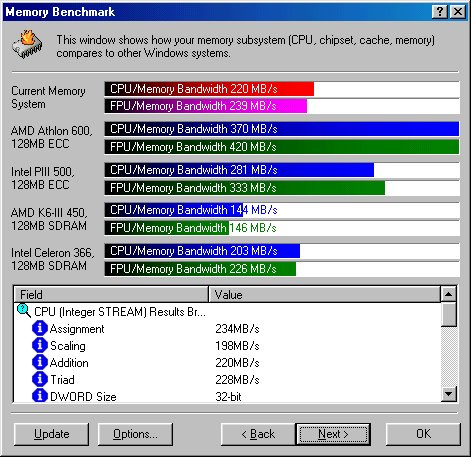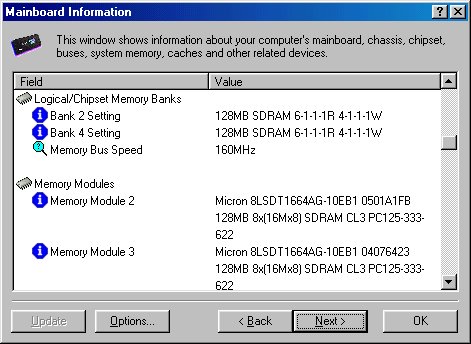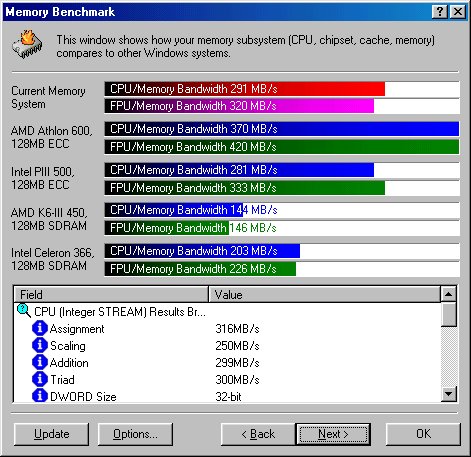THE
BAD Right
off the bat, not too many bad things show up with the board, although a few cracks
start showing after some extended use. The first problem I ran into was when I
went to install my PPGA celeron 300a with a GlobalWin CPM25603-12 heatsink. this
particular heatsink sticks out around the CPU by about a quarter inch. The problem
is the CPU socket lever used to open and close the socket, has a bend near the
end to make it easier to grab inside a messy case. Unfortunatly it is bent up
so far as to interfere with the heatsink and not allow it to sit flat. This is
not a problem if you use retail heatsink but this is quite a shortfall for anyone
else who prefers to use non-intel sinks. It does state in the manual that a "Pentium
3 Socket 370 processor with built-in CPU cooling fan (boxed type) is required",
but this board is aimed a little higher than new users who are going to use retail
processors and it's unfortunate that Soyo didn't allow for larger heatsinks. The
problem can be solved by rotating the socket lever 90 degrees outwards, but that
should be left to experienced useds who understand just exactly what their doing,
as well there is the risk of breaking something and I'd take a wild guess that
this blows your warrenty sky high.
The second problem that cropped up
was the RAM slot placement. Once you have installed the RAM and AGP card, the
AGP card blocks access to the lower RAM slot releases. This is not only a problem
with larger AGP cards, our relativly small Voodoo 3 test card fit completely blocked
all access to the lower releases. This is not a great downfall by any means, just
a pain to have to remove the AGP card to add or remove RAM, the only time that
this would be incrediablly annoying is if you were trying to disgnose a RAM problem
where your swapping modules in and out.
One very interesting problem
I encountered while testing the board was a BIOS issue. If the user sets the FSB
to 100MHz, the CAS latency to 2, and the RAM clock to FSB+33MHz, a BIOS failure
occurs upon re-boot. The problem occurs no matter the RAM used or other FSB settings
in the "100MHz FSB catagory". Although the problem looks serious when you reboot
to loud beeping and the message "BIOS Checksum Failed", it turns out to be simple
to resolve. Interestingly enough, the problem does not occur in the 66MHz FSB
mode, and you cannot set the RAM clock to FSB+33Mhz while in 133MHz FSB mode.
The problem can be resolved by shorting pins 2-3 of JP5 to clear the CMOS. Click
here for more detailed instructions. The problem exists in all BIOS revisions
through 2AA3.
We notified Soyo of our findings and they were able to
reproduce the problem in their lab, confirming our findings, but were not able
to offer any fixes. Soyo was not able to get a new BIOS revision out in timly
manner that fixes the problem, but do promise that it will be fixed in revision
2AA4. Although not being able to run your RAM at 133MHz CAS 2 is disappointing,
and moreso when you consider the poor RAM performance we experienced, it's not
a serious shortcoming.
VIA
has always seemed to produce great chipsets, including the Apollo Pro 133, but
one problem they've never been able to overcome is absoutly pathetic RAM performance.
Running a business and light gaming machine, one is not likely to notice, but
load up Quake 3 and it's quite apparent that something is very lacking. This pretty
much sums up the performance:

About
the only system that the soyo was able to top was an ancient Super 7 K6-3, even
a Celeron 366 on a 440BX board is faster. But the story does get somewhat better
with some major overclocking and BIOS tweaking. This is a Pentium 3 650 @ 120MHz
FSB and RAM at 153MHz (FSB+33MHz) (153MHz) and it only starts to perform up to
P3 500 on a BX board.


With
some tweaking and major overclocking of the RAM, the VIA chipset starts to catch
up to the rest of the pack, but the rest of the pack has been out on the market
for almost 3 years now.
Stability
and Overclocking
Although not nearly
as overclocking oriented as ABIT boards, the 7VBA 133 does give good room to bump
up the MHz.
The CPU core voltage can be bumped up by 3%, 6%, or 10% via jumpers.
Although 10% is not much, it's well within the general guidelines for safe (I
usually say +15% vCore max), and is usually enough to get those last few MHz.
That combined with the generous front side bus options and excellent RAM settings
nets a decent overclocking board.
There
is also a nice selection of bus speeds to choose from, 27 to be exact, with a
good spread over the entire range (66-155MHz). But easily the most usefull overclocking
this board provides is the RAM overclocking. The ability to control the timings
on a per bank basis combined with an independand clock generator and the shear
number of tweaking options makes this the shining point of this board. So if your
RAM can't handle the 140MHz FSB your running, drop the RAM clock by 33MHz and
your on your way. Or the other hand if your still squeezing those last few MHz
out of a celeron and you can't hit a 100MHz FSB, up the RAM clock by 33MHz and
keep those textures flying.
Under normal
use, board stability is excellent, I experienced no crashes whatsoever. Even 24
hours of MP3 encoding, looping UT demo, and running Distributed.net's RC5 client
combined with general system use did not cause any crash's. And when you combine
this stability with the included VIA Hardware Monitor, this board turns into a
rock. It keeps an eye on those critical voltages and fan RPM's for you, and lets
you know the moment something goes awry.
However,
under overclocked situations stability is okay, although not excellent. When overclocking
the grand-daddy celeron 300a to 450Mhz there was no problem. At 473MHz (105MHz
x 4.5) at 2.2v (+10%vCore) random re-boots and partial system crash's were common.
The story is pretty much the same with a brand spanking new P3 Coppermine
650 at the helm. Clocked at 820MHz (6.5x126MHz) the board will run every single
stress test that I can throw at it for 2 days straight, and then spontaniousouly
re-boot while surfing the net. One interesting thing I noticed is that stability
has alot to do with the ambiant temperature. My trusty BX system has absoutly
no stability problems when the ambiant temperature gets up to 25C plus, but the
Soyo exhibited very poor stability when the ambiant temperature started to rise
above 23C. Keeping the system at a steady 20C increased stability quite noticably.
